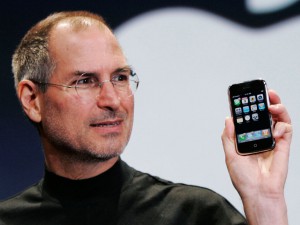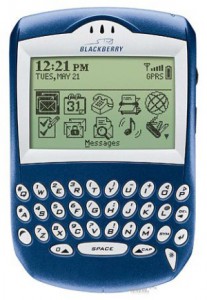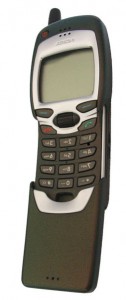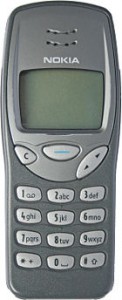Apple’s launch of the iPhone was one of the defining moments in the mobile phone’s history, so it’s ironic that Apple’s launch smacked more of panic than of an attempt to change the course of mobile development.

True, there was much the iPhone had, that seemed new – the trademark Apple operating system and interface, the touch screen, the elegant navigation, but the truth was the iPhone was a marker in time and the decision that made Steve Jobs’ reputation with the phone, was to launch when he did.
The line in the sand
It was a moment of decisiveness which meant – that rather than Apple winning, that all of the other mobile phone manufacturers lost – Apple gained the momentum to push it nose, head and shoulders ahead of the opposition.
An opposition which in truth had been dithering, because there was nothing much that Apple did that was different from what all of the manufacturers were working on – apart from the Apple interface.
A world of possibilities
A year before the launch of the iPhone in fact, the world of the mobile phone manufacturers was a frantic place of feverish innovation as each company manoeuvred to try and find the one component to redefine the mobile phone as the smartphone.
According to the theorists, we were about to enter the world of personalisation and the mobile companies were determined to get it right because mobile had already shown an unnerving habit of surprising people.
The Jean Paul Gaultier’s of industrial design, concept houses like Idem, had even been suggesting that this world could become even more surprising, and predicted a world where the mobile could even abandon the plastic and metal that had cased it before and start to offer phones made of leather, wood and stone and other materials to cater to an untapped market for the distinct.
Defining the fashionable for the mobile phone

Phones would become fashion statements, and phone cool would be chic. It was a possibility that the analysts Gartner, were keeping a beady eye on, trying to weigh up whether the beautiful people would achieve more clout than those other dictators of the mobile market – the techno-nerds, and the function die-hards, who would sooner dispense with a favourite pet than much loved gadgets such as the Nokia Communicator – lovingly dubbed ‘the brick’ by its owners.
Form or function
True, a few attempts had been to break ground by both camps.

Mobile phones had been sold encased in diamonds and gold, car companies like Jaguar and Porsche spawned their own phones and Blackberry had appeared on the scene in 1999, with a passable attempt at a ‘communicator’ that tried to appeal to both the functional and the form obsessed by looking as though someone had taken a Nokia 3210 and flattened it out with a steam roller.
A confirmation of the conservatism that had bedevilled the mobile’s development because the market had bucked the manufacturers over and over again.
The shock of the mobile
In the UK and in the US, the rapid adoption of the mobile phone had been against all expectations.
According to Sir Bryan Carsberg, in 1984 the UK’s first telecom regulator at Oftel, now better known as OfCom, the powers that be thought that mobile would be a niche market for only around 100,00 customers because of its £2,000 entry price.
“Competition has drastically changed that. In the late 1980s I was working on models that presumed 10m customers by the end of the 90s and everyone said I was way out. What’s the number of mobiles in the country today? I think it’s around 50m,” said Carsberg in an interview with Fi in 2006.
To achieve such dominance the mobile had to become cheap and portable, so it became small but along the way something else unexpected occurred – people discovered texting and gaming and the mobile began to evolve into a universal communication device.
Texting a surprising message

Texting was just another one of those technological hiccups that had taken the market by surprise. It was initially seen as a little piece of window dressing to occupy some bits and bobs of unused bandwidth, but the 140 byte Short Messaging System became an overnight success story to the surprise of the companies that offered it. Rather a large surprise, now it has become the world’s most widely used data application used by 74% of all mobile customers.
It had definitely not been a flawless evolution and attempts to push the market had seen a few false starts – Nokia, the BBC and BT had encouraged the development of Wireless Application Protocol in 1999 and massively over-hyped the technology with the result that disappointed customers branded it ‘Wait And Pay’ and the ‘Worthless Application Protocol’ but the demand pointed the way for the manufacturers.
People did want to access information anywhere and they would pay for it but they did want it to work so the race was now on to deliver that.
Model problem – pretty but functionally challenged

Nokia’s iconic 3210 had shown that small was beautiful in 1999, and the interchangeable covers brought in a year before on the 5100 had hinted at the most rudimentary personalisation but small, while sexy was not functional and though the mobile phone was now a fashion accessory the mobile’s great argument had begun what was more attractive – form or function.
For the mobile industry it remains a thorny issue, because the drivers in mobile, fashion accessory and functional universal communicator are contradictory due to several technological hurdles, power, input and screen size all of which impose enormous constraints on design.
The designers had suggested several possible innovations to get around this, some of the most novel being to separate the headset from the processing and the power.
For women this could mean making jewellery that combined blue tooth headset earrings with necklaces packed with chips and rechargeable batteries and the option of a mirror that doubled as a screen and keyboard.
While for men something equivalent that involved bluetooth headsets and a portable screen and processor carried in a wallet was and still is envisaged.
A solution that should remind everyone that uniting the headset and the guts of the phone was simply a marriage of convenience decided on by the manufacturers and that separation has never been far away, indeed it has been the natural state for the phone for the bulk of its existence.
What’s weighing down the mobile world
Despite such attempts to work around the problems though they are at most a halfway house.
The scientists working on batteries have made little headway for over a 100 years in finding an effective lightweight material to hold power for long periods of time.
Incredible efficiencies have been made in the circuitry that handles the functions of the phone but until new lighter materials that can hold more power are found, the battery remains the largest part of a mobile phone.
While input has meant that to be able to pull and enter information we need some form of keyboard and the size of our fingers now dictates how small that keyboard can be.
The lure of the small screen
The final factor, screen size had also become an issue.
The 3210 had gone down to the smallest a screen could be for the purpose of texting and using the mobile as a phone but the manufacturers had realised that there was now a developing market for the phone as an entertainment device to watch videos and play games and the screen would become a crucial factor in the development of that use.
Interestingly early research from companies like the US mobile bedrock company MediaFLO – which provided services the mobile phone operators sold onto their customers – found that people could be enormously tolerant of small and even poor screens so long as the sound quality was high.
The research even found that people would continue watching video on their mobile phone even after they had entered a room with a conventional TV in it.

A finding put to good use on the in-flight entertainment systems of virtually every modern airliner. Provide good audio and people will watch the smallest of screens.
Improve the screen resolution and people will happily watch on the smallest screen.
A development that also allows people to exercise choice – a process that the modern age defines as an extension of democracy – being able to watch what you want takes you away from the tyranny of the schedule and provides the enticing prospect of not only being able to chose your own media but also to be able to make it.
The temptations of technology
To add to these three thorny issues there were other technologies that all promised to be game changers that were all tantalisingly below the horizon – plastic metals, oled screens, voice recognition, flexible electronics, air screens and keyboards.
All beguiling technologies that could either give a mobile manufacturer the winning post or consign them to oblivion.
Adopting the high resolution Organic Light Emitting Diode screens not only meant that high quality video could be played, it also allowed the keyboard to be dispensed with by putting it on the screen and adopting touch screen technology, but research had shown that psychologically people still need the reassurance that they are typing, so if you are going to provide a screen keyboard it has to provide ‘haptic feedback,’ the sensation that a key has been depressed by providing either a vibration of a movement to the finger tips.
While plastic metals, a research that Nokia had invested much into meant that the phones themselves could change shape – that a keyboard could be pulled out and would actually stretch slightly.

Just as attractive is the possibility of developing a keyboard made of light, using a combination of infra-red and low intensity lasers. The infra-red, defines the area of the keyboard while the laser creates a field of light that can detect when it is interrupted by your finger and the computer program running the system can then interpret that into a a position and a keystroke.
Other similar technologies offer the prospect of doing away with the screen by beaming light up into a bisecting matrix – still in its infancy the systems can at the moment beam a screen onto a wall or a piece of paper in the same way that images can be projected onto buildings as part of a laser show.
The siren sound of voice recognition
All developments that could suck up research and production budgets only for the company electing to follow that route to suddenly find that voice recognition technology has finally conquered the final issue of achieving an accuracy higher that 97% and made the keyboard completely redundant.
A world fraught with dangers for the mobile manufacturer and one where an entire assembly line can be wiped out overnight.
As the iPhone proved, get it right and you win the house, get it wrong and you won’t even get room in the dustbin.
Thus for Apple’s Jobs the decision in a world of indecision must have been a simple one, “what is possible now? What do people want and how can I give them that?”
The answer was a simple one.
Make the most out of the one thing that you can do to reduce space -get rid of the keyboard and deliver the biggest screen that you can, and incorporate the keyboard into it using the touch screen technology being experimented with by all of the phone manufacturers.
Create an interface that can take advantage of the latent appetite for personalisation which had not been effectively catered too – let people design their own interface on the screen.
A little bit of application
And finally, Jobs’ greatest triumph of personalisation, turn the victory of the old enemy back on itself to ensure that you have a captive market.
Just as Microsoft made sure when it captured the entire PC market that things would stay that way by encouraging other companies to write applications for Microsoft’s software, Jobs’ showed that he had taken that lesson to heart and made it his own.
By opening up the iPhone to ‘apps,’ the market could customise its phones to do as many things as the applications developers could come up with – people might be being offered any shape they want as long as its iPhone shaped – but, just as in the British council houses sold to the tenants by Margaret Thatcher, the owners can change the doors and windows, and build extensions.
A world that has still stayed very familiar.
The myPhone revolution
Though Goggle’s android is now threatening the iPhone council housing estate, many of the houses still look very similar and the constraints that have held back mobile design are still dictating a manufacturing conservatism that Apple only bucked with a moment of decisiveness.
New developments in mobile banking and the use of mobile phones as payment devices, predicted by Fi seven years ago, are all going to push the mobile further along the functional road, a capability anxiously being pushed by both mobile service providers and new entrants into the financial services community as they seek to take advantage of the next stage on what is called ‘convergence’.
Ironically, though it is a movement that is now all waiting for the sound of one voice, not now Steve Jobs’ – the King is Dead – but the voice of the consumer saying its first few hesitant words using voice recognition systems.
The absolute game changer, as effective voice recognition, will signal the end of the keyboard, allow the development of a usable biometric for financial transaction security and unique identification by the phone of its owner – it will also transfer a little of the balance of power back to the beautiful people.
As yet though it is a voice in the wilderness and we wait, though on the evidence of events to date, many would bet that the customer might still have quite some say in the development of the mobile.

